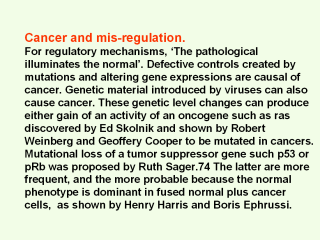 |
Cancer and
normal cells differ in their surface chemistry and
functions. Proliferation is improperly regulated by cell-cell contacts,
serum factors, etc. Hormone and growth factor
receptors are quantitatively and qualitatively
modified. Membrane carbohydrates are altered 75 and phospholipid turnover
increases.76 Rates of transport of small molecules
into cancer cells and into normal cells differ. Again,
one finds roots in genetic—environmental miscommunication,
here due to imperfect signaling between cells of a
multi-cell organism. 77 Many intracellular regulations
also are changed. The first proposal for a biochemical
basis of cancer made by Otto Warburg was misregulated
production of energy (ATP) by glycolysis vs. respiration.78 |
